Anarchist4000
Veteran
Those are the FP16 rates that are coorelated. If applications are making heavy usage of FP16 it would be foolhardy to think the device with double the theoretical figures wouldn't be faster. And I was comparing to Pascal, but it may apply to Volta. As for current comparisons Polaris looks to be doing just fine and pulling ahead in newer titles as expected.Its like you trying to compare 25 tflops of 16bit precision to Volta's 32 bit flops to prove a point, you just don't do that, two totally different metrics which have no correlation with each other.





